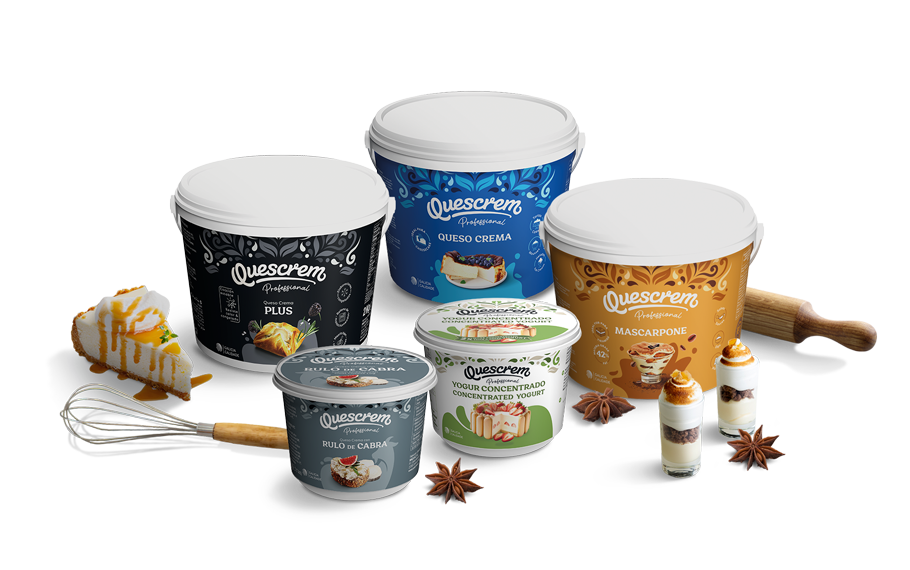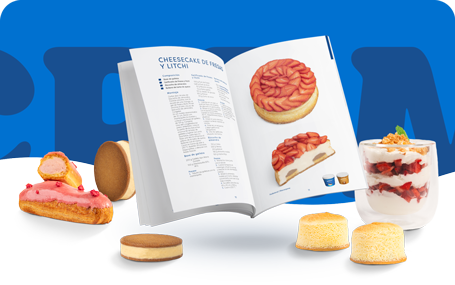A good sauce can transform the simplest of dishes into an experience for the palate. Sauces are an important part of cooking and one of the secrets of great chefs to make their creations reach a higher level.
Sauces are not only used as an accompaniment to a dish, but can also be used for stewing or braising food. A good sauce can be based on ingredients as varied as broths, alcohol, vegetable puree or dairy products such as cream, yoghurt, mascarpone or cream cheese. In this article we will examine all the steps steps to make a perfect sauceThe course will cover everything from the different types, to the key ingredients and techniques. Upon completion, you will have the key to how to achieve a perfect sauce and successfully incorporate this element into your restaurant’s menu.
The types of sauces that every cook should know about
Every gastronomic culture spread across the five continents has its own recipes of sauces identifiable with their culinary identities and local flavors. These sauces can be served cold, warm or hot and provide us with flavors that are sometimes salty, sweet, spicy, bitter, sour, sweet and sour, and so on. However, the concept of a dish with sauce can be very simple, something as basic as cooking meat, vegetables or legumes in a liquid medium full of flavor. From there, a whole universe of complex and nuanced sauce recipes opens up to accompany our dishes and add value to them. There are two main categories of sauces: 1. Mother or base saucesThese are basic sauces characterized by a specific combination of basic ingredients and the combination of one or more preparation techniques. They can be used by themselves to season a dish or they can be the base for the preparation of other more complex sauces as they can be easily enriched. Without a good base there is no good sauce, Therefore, special attention must be paid to the preparation of the mother sauce. The name of base sauce should not lead to confusion about its preparation process, since many have a long and meticulous preparation process, as is the case of a dark veal stock that requires prior roasting of the bones and subsequent cooking for hours. The most common techniques used in the preparation of base sauces are cold or hot emulsion, roasting and poaching. Some examples of base sauces sauces made from base ingredients: [table id=”3″ /] As we can see in the table above, many of these base sauces are based on the preparation of a stock, which is the essential and fundamental component of many traditional sauces in our country. These more or less concentrated aromatic liquid preparations are obtained by cooking for a long time in water ingredients such as poultry carcasses and bones, veal bones; scraps, heads and peelings of fish and shellfish; or dry elements such as bonito flakes, shrimps, etc. The aromas contained in the ingredients will gradually diffuse into the liquid by the phenomenon of impregnation. In turn, two types of backgrounds can be distinguished, the white backgrounds white funds in which ingredients such as bones are used raw or simply blanched; and the dark backgrounds, in which dark stocks in which these same ingredients are dry roasted in the oven or sautéed in fat to caramelize them and give them the characteristic dark color that will become the sauce. 2. Derived sauces are more complex sauces and the result of adding additional ingredients and techniques to a mother or base sauce. The most common techniques used in the preparation of derived sauces are binding, either by reduction or by adding thickeners, in order to give it greater consistency and to integrate other ingredients into the base sauce. The same base sauces of the first table used as an example, can be transformed by applying additional techniques and/or adding other ingredients and give rise to the following types of derived sauces: [table id=”4″ /]Technique in the preparation of perfect sauces
The technique we use in the preparation of a sauce is the key to its success. in its preparation. We always attach great importance to the choice of quality ingredients, but special attention should also be paid to the shape and size of the cuts of the ingredients, which will depend on the duration and cooking technique used in the preparation of a sauce. Below we highlight some of the basic tricks to achieve a perfect sauce:- In most of the funds, the garnish is cooked in a liquid for several hours, so we keep the elements whole or in large portions to prevent them from disintegrating and clouding the liquid (carrots, onions, ginger, leeks, etc.).
- For short or fast cooking sauces, however, a very fine cut (brunoise type) is preferable, to allow the elements to pass their aroma to the sauce quickly.
- It is also interesting to tie some ingredients such as aromatic herbs for prolonged cooking in a bouquet garniso that they can be easily removed at the end of cooking.
- It is also advisable to isolate berry or seed type ingredients to prevent them from being dispersed in the liquid, for example: cloves enclosed in an onion, juniper berries and peppercorns enclosed in gauze or a tea bag.
Additional ingredients in sauces: complexity and aroma
We have already seen how we obtain a base sauce from basic ingredients and how by adding additional ingredients, we obtain more complex sauces which we call derived sauces. These additional ingredients deserve further explanation because they will determine the complexity and character of a perfect sauce. The additional ingredients besides giving us flavor and aroma also help us to emulsify, thicken or give the perfect texture or finish to a sauce. Let’s dwell on each of them to examine them in depth:1.The aromatic garnish
The ingredients that make up the aromatic garnish of a sauce enrich the flavor and add aroma, which is why it plays a fundamental role in the preparation of any sauce. This aromatic garnish is mainly composed of a mixture of vegetables and greens that will diffuse their aromas in a base liquid. Care should be taken not to exaggerate the quantities, as the vegetables and herbs should emphasize the flavor of the basic ingredients and enhance but not mask them. The choice of the composition of aromatic ingredients varies according to the background elements, but also according to the geographical origin or the specific aromatic notes to be added to the sauce. Classic Spanish cuisine uses ingredients such as garlic, carrots, onions, bay leaves, parsley, pepper, etc. in its most popular sauces. On the contrary, in Asian cuisines we will find ingredients such as ginger, galangal, lemongrass, kaffir lime or fresh turmeric. Another example is the use of peppers, chili peppers, garlic, lime, cilantro in Latin American cuisines.2. Seasonings
Seasonings will mainly provide us with the basic flavors of a sauce, whether salty, sweet, sour, bitter, spicy or umami. They also have the quality of providing aroma, although this is not their main role. Once again, their choice varies greatly depending on the nuance you want to give to the preparation and the geographical origin:- Salado: salt, soy sauce, fish sauce, etc.
- Sweet: sugar, honey, maple syrup, fruit juice, etc..
- Acidity: citrus juice, vinegar, etc.
- Umami: kombu seaweed, soy sauce, etc.
- Bitterness: endives, botanical extracts, angostura, etc.
- Spicy: garlic, pepper, chili peppers, Sichuan pepper, etc.
- AstringencyRed wine, tea, garlic, currant, blueberry, etc.
Complementary aromas
In addition to the basic aromas provided by the basic ingredients and the aromatic garnish, it is common to develop the aromatic structure of a sauce by adding different elements that will add personality to the whole:- Aromatic extracts: truffle juice, Nuoc Mam sauce, various essences, etc.
- Alcohols: white or red wine, cognac, xerry, port, oloroso, brandy, sake, mirin, etc.
- Spices and similar: juniper berries, cloves, allspice, licorice, etc.
- Herbs or similar: basil, cilantro, linden, etc.
Thickening ingredients
Although we can use the basic reduction technique to thicken a sauce, there are also ingredients that are used to bind and thicken a sauce and give it a creamy, coating consistency, examples of which are:- The white, blond or dark roux: preparation cooked with flour and butter (or oil), and which is probably the best known technique.
- Starch: cornstarch, potatoes, arrowroot.
- Protein coagulation: adding and cooking eggs or blood.
- Texturizer: such as guar gum or xanthan gum.
5.Emulsifying ingredients
Dairy products such as butter, cream or cheese, which are widely used in Western cuisines, are especially used in cooking. In Asian countries, pork fat is widely used for emulsifying. Among all the emulsifying ingredients we highlight the cream cheese, an increasingly valued ingredient in the elaboration of sauces in the professional kitchen.. It has the advantage that it not only acts as an emulsifier, but also has the ability to function as a thickener. If we choose a quality cream cheese, it can also help us to enhance the aromatic notes and flavor, as well as add important organoleptic properties to our sauce. We will further develop the infinite possibilities that this ingredient gives us, as it deserves a separate attention.6.Finishing elements
Once the sauce is ready to serve, it is often garnished with various toppings or finishing elements to complete its preparation:- Vegetable scent: fresh herbs such as parsley, tarragon, chives, basil, cilantro, mint, etc.
- Freshness: fruit brunoise, citrus zest or juice, etc.
- Gloss: oil, butter, marrow, etc.
- Crunchy: croutons, chopped vegetables, fried ingredients, etc.
6 reasons why cream cheese is the perfect ingredient in your sauces
As we have pointed out when we talked about the different categories of ingredients that a sauce can contain, cream cheese is much more than an emulsifier and can become our perfect ally in the preparation of an infinite number of sauce recipes. perfect ally for the elaboration of an infinite number of sauce recipes, from the basic to the mostfrom the basic to the most complex sauces. Both Quescrem Natural and Quescrem Mascarpone are ideal for sauces, but so are other varieties of Quescrem that allow us to easily and quickly add special flavors such as blue cheese, goat cheese, yogurt to our sauces.Here are 6 reasons why cream cheese is the perfect ingredient for your sauces:
We enhance the flavor and aroma of the sauces.
The use of cream cheese in our sauces can help us both to soften strong flavors and to enhance their aroma and flavor. If we use cream cheeses with a strong flavor (blue cheese, goat cheese, manchego, etc), we will help to give personality and a different touch to our sauce. An example of this is this recipe for chicken sandwich with goat roll. This snack is ideal for restaurant or bar service as well as for delivery, with a sauce made with Quescrem Rulo de Cabra which offers the authentic flavor of the traditional rulo in cream format, with zero waste and a considerable time saving in the preparation of any sauce by not having to manipulate the cheese at all. Another example of flavor enhancement through cream cheese is this recipe for fish balls and yogurt sauce. fish meatballs and yogurt sauce, in which the yogurt sauce in which the yogurt sauce mixed with garlic, shallots and lime achieve a perfect harmony with the flavor of the hake and vegetables used in the preparation of the meatballs. Any of our cream cheese varieties can become a quick sauce to accompany pasta, vegetables, meat or fish. Without the need to add thickeners, you will have a sauce with a perfect consistency and texture for both hot and cold sauces and with a variety of powerful and authentic flavors: blue cheese, goat cheese, garlic and fine herbs, etc.Binding power of other ingredients
This is the case of our Quescrem Culinary Yogurt which allows us the perfect emulsion of liquid ingredients and the addition of acid without being cut, in addition to the contribution of a differentiating flavor like yogurt for our sauces. An example of this is this recipe for chicken tacos with yogurt and lime sauce in which we have easily emulsified our Culinary Yogurt with milk and the juice of a citrus fruit such as lime to obtain a delicious sauce.Thickening without fat and making the most nutritious sauces
Why not use cream cheese for thickening? This function is also perfectly fulfilled by our Mascarpone Quescremin both its standard and lactose-free versions. Its composition and its fat percentage of 42% makes it a perfect substitute for butter, oil or cream, reducing processing times and in many cases improving the nutritional values of the recipe.A gluten-free substitute for bechamel sauce
It is not easy to produce a quality béchamel sauce without gluten. However, it is an increasingly frequent demand in catering establishments. The Quescrem Plus cream cheese helps to achieve this, since it is a product designed for cooking with which any type of filling for croquettes, peppers, pasta, etc. can be made, easily replacing bechamel sauce and saving time and effort. A perfect example is this recipe for gluten-free curried chicken and cheese croquettes, which shows the advantages of this product: faster and time-saving preparation; simplicity when mixing, rolling, battering and frying, and excellent creaminess inside.Lump-free, glossy sauces
Not all sauces need to be thickened with starch or flour, especially if we want to avoid gluten in them. That is why cream cheese is the perfect substitute for it. It will help us to achieve shiny sauces without the risk of lumps. This recipe for pork tenderloin with goat curl sauce is a good example of this. is a good example of this.Suitable for both hot and coldfor both hot and cold sauces
Another advantage of our cream cheeses and their versatility in the preparation of sauces is that they are ideal for both hot and cold sauces due to their good temperature resistance. This example of a recipe for creamed mushrooms is perfect to illustrate it, since not only do we heat the cream cheese in the previous preparation of the sauce, but afterwards the recipe has a touch of baked au gratin. The result is that none of the creaminess is lost and the sauce remains juicy and unctuous.We reinvent some sauces of international cuisine with cream cheese.
Based on the reasons we have given you as to why the use of cream cheese in the preparation of your sauces can be an added value in your kitchen, we review some of the most classic sauces and we propose you to change the chip and replace some of the most classic ingredients with some of the cream cheeses and mascarpone we make at Quescrem.- Supreme sauce. This is a a white sauce derived from a velouté sauce (a roux made with meat stock) and reduced with a fatty ingredient such as butter or cream. Our bet is to substitute this fatty ingredient with our Mascarpone Quescremnormal or lactose-free version. We will obtain an extra creaminess and smoothness, a magnificent emulsifying power and we will improve the nutritional profile of our sauce.
- Albufera sauce. Another sauce that can also benefit from the substitution of butter or other fats for mascarpone is one of those derived from the supreme sauce itself. We are talking about albufera sauce which differs from its sourdough in that it is enriched with a demi-glace obtained from the reduction of a dark veal stock.
- Bechamel sauce and soubise sauce. Both the bechamel sauce and the sauce derived from it to which an onion puree is added, are soft and succulent sauces that are usually used for gratin and in which we can perfectly replace the flour and butter for our Quescrem Plus. We will thus obtain a gluten-free substitute that will give us an extra creaminess and that will be ideal for preparations with bechamel sauce or its derivative sauce.
- Hollandaise sauce. Hollandaise sauce is an emulsion made with egg yolk, butter and an acid such as lemon juice or vinegar, in which the ingredients are emulsified by beating in a bain-marie until a thick, frothy cream is obtained.. It is a sauce with a high degree of difficulty due to the risk of it cutting and its instability. A quick option for hollandaise sauce is to substitute or reduce the amount of butter and use Mascarpone Quescrem in its preparation, thus eliminating this characteristic instability due to the stable structure of this cream cheese.
















